Located on the eastern coast of Rügen is a piece of German history, that until two years ago I had heard nothing about. And yet, it stretches over 4km along that coast.
Nicknamed the “Koloss” of Prora, it is a remnant of the 1930s when Nazi Regime was looking for large building projects to show of their strength and get people back into work at the same time.
The idea was for a seaside resort for “normal” families, the type that would not otherwise have been able to go away on holiday. But rather than encourage individual tourism in the area, they went for something much grander: a complex where 20,000 people could all stay at the same time.
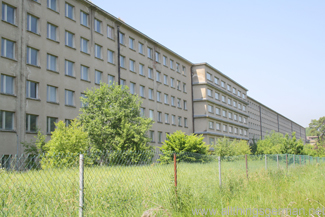
The seaward side of the building in Prora
Families would pay a certain amount each week in a fund run by the “Kraft durch Freude” (“Strength Through Joy”) organisation, and when they had paid enough they could board a train to the new station at Prora from where it would be only a short walk to the entrance of the complex. There they would be assigned their room numbers. With every bedroom in the complex having a sea view and the front of the building being directly at the beach, just the idea of such a holiday must have been a dream come true for many in those days.
With the foundation stone being laid in 1936, the complex was a sort of competition between the major building companies of the time, many of whom are still in business today. The railway line and station were not only built, they are still serviced by Deutsche Bahn today. But the outbreak of the Second World War saw construction work halted, with only the shells of the 8 main buildings and one of the entrances being finished. The second entrance area, the festival hall, the tower, swimming pools, and dining areas were still missing, and the two quays were just stumps rather than their full lengths.
Apparently some work continued on parts of the building, which from time to time did see some inhabitants, be it refugees or the injured. In fact, the building had been designed with a secondary use as a hospital. Although it allegedly only saw a few weeks of use as such towards the end of the way, this was reason enough for the Red Army to decide to blow the complex up.
With one of the 8 buildings for sleeping accommodation they did just that, but then decided that given the number of refugees on the move in Europe and their own need for barracks in Germany, it would be a waste of a good building.
In the end two more of the units were used by GDR forces for practise with explosives and their remains can still be seen. Otherwise the remaining 5 units are still standing. Some have found new uses, some are derelict.
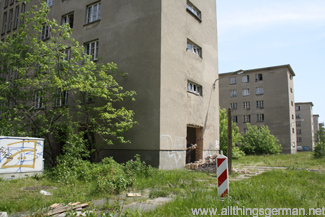
The landward side of the building in June 2013
When the Red Army left, the Nationale Volksarmee (NVA) of the GDR moved in. They used part of the complex as barracks and part of it as a seaside resort for their officers and their families.
However unlike previous plans for the prestigious object to be visible from the sea, they allowed trees to grow up between the accommodation buildings and the beach to hide it from view. The other side of the building was already hidden from the new road and the train line by woods, and so Prora effectively disappeared off the map.
According to local residents, it was an open secret. No-one dared talk about it in public, and officially no-one know it was there. But with so many military personnel on the island and with locals remembering the construction, people were able to put two and two together.
Now the entire complex is a listed building. And a large one at that. With each of the accommodation blocks being 500m in length, it can take an hour just to walk the length of it in one direction.

Inside one part of the building during re-development
Two of the blocks are – with the permission of the listed buildings authority – being re-developed into flats and a hotel. Balconies are going to be added to the seaward side, with the sea views now only visible from the first floor and above. In some parts the ground floor will be connected to the first floor to form maisonette flats, and in others shops and services will and planned.
One block contains a museum to the Nationale Volksarmee and part of the entrance area contains a documentation centre. Both of these will feature in separate articles.
Part of one building contains a youth hostel for 400 people, which considering its location near the station and next to the beach is perhaps not unsurprisingly popular.
And the area originally set aside for cultural activities near the entrance is now home to the M3 Disco, which is probably the ideal location for it given there are are no neighbours for at least 500m but a car park, bus stop and station nearby. Even the nearest of the new flats will still be 1km away!
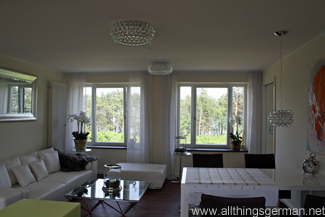
A flat in one part of the building, used to show prospective buyers what they might like look
Unlike many relics of the war, Prora is not so much a place of remembrance as somewhere that was, and still remains in part, functional. You can be impressed by the energy that the builders must have put into building it, whilst at the same time being shocked at what Germany may well have looked like if more such complexes had been built and indeed a further four were planned along the coast.
It is when you hear the finer details, such as the plan to put a loud speaker in each room and to keep tabs on the holidaymakers during their stay, that you see how much this “holiday” complex was really going to cost Germany and its citizens.
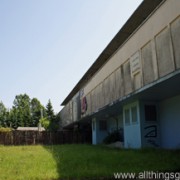
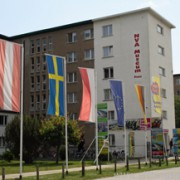
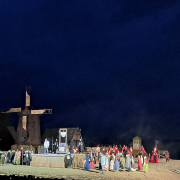


Speak Your Mind